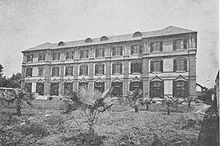Utopia University
| 大同大學 | |
 |
|
|
Former names
|
Utopia School |
|---|---|
| Type | Private |
| Active | 1912–1952 |
| President | Hu Dunfu |
| Students | 2,700 (1948) |
| Location | Shanghai, China |
| Utopia University | |||||||||
| Traditional Chinese | 大同大學 | ||||||||
|---|---|---|---|---|---|---|---|---|---|
| Simplified Chinese | 大同大学 | ||||||||
|
|||||||||
| Transcriptions | |
|---|---|
| Standard Mandarin | |
| Hanyu Pinyin | Dàtóng Dàxué |
| Wade–Giles | Ta-t'ung Ta-hsüeh |
Utopia University, known in Chinese as Datong or Tatung University, was a private university in Shanghai. It was established in March 1912 by a group of former Tsinghua faculty members led by Hu Dunfu, and became one of the most reputable private universities in China. After the founding of the People's Republic of China, the Communist government closed Utopia along with many other private universities in 1952. Its departments, faculty members, and students were divided and merged into various universities in Shanghai.
In April 1911, the American government established Tsinghua College (now Tsinghua University) in Beijing, using part of indemnity payment made by the Qing dynasty in the aftermath of the Boxer Rebellion. In summer, a group of eleven Chinese faculty members at Tsinghua, most of whom were from the Jiangnan region, established the Lida Society (立達學社) to promote education in China. Hu Dunfu was the head of the society, and other members included Ping Hailan (平海瀾), Zhu Xiangwan (朱香晚), and Gu Yangwu (顧養吾). In November 1911, the eleven members of Lida resigned from Tsinghua after having a disagreement with the American administrators at the college, and left Beijing for Shanghai.
In Shanghai, Hu Dunfu was invited by Ma Xiangbo, his former teacher at the Catholic school Collège Saint-Ignace, to be the dean of Fudan Public School (now Fudan University), which was founded by Ma in 1905. However, Hu soon left Fudan after a student strike at the school. In March 1912, Hu and his colleagues of the Lida Society founded Utopia School (大同學院) in Nanshi, Shanghai, with Hu as president. The inaugural class had 91 students.
In September 1922, Utopia School was certified by the government as a private university, and changed its name to Utopia University. It had 600 students at the time. In the 1920s, Utopia developed into one of the best private universities in China. It was divided into three schools, for literature, science, and business, which were further divided into nine departments. It also established an affiliated secondary school. The campus occupied an area of 90 mu, and had 15 buildings. A 1920s inspection report of six major private universities in Shanghai by the Chinese Ministry of Education praised Utopia and University of Shanghai as the most outstanding. Nationally, Utopia and Nankai University in Tianjin were considered the best private universities in China.
...
Wikipedia
